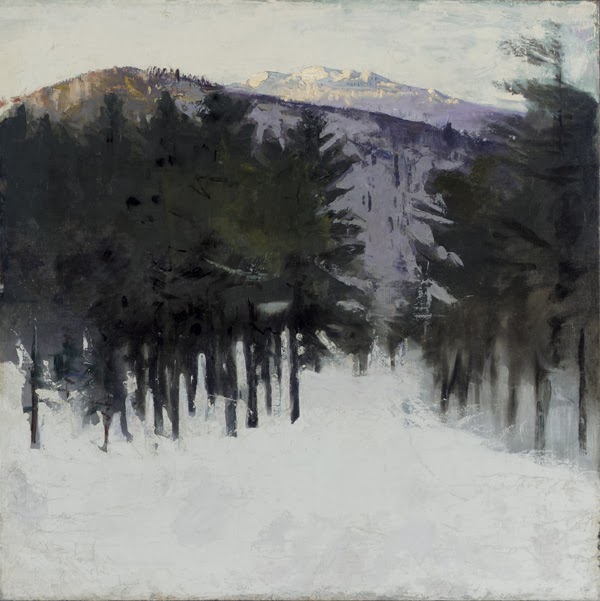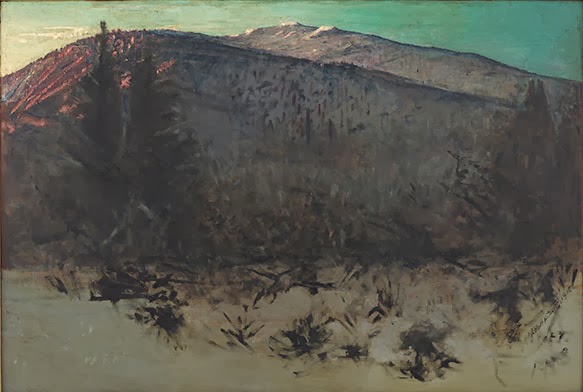 |
| Abbot Handerson Thayer, Winged Figure, 1889, The Art Institute of Chicago |
 |
| Abbott Handerson Thayer, Angel, 1887, Smithsonian American Art Museum Gift of John Gellatly Mary, the artist's daughter, posed. |
After moving to Washington, I found that Thayer is represented well in the nation's capital. Angel of 1887 is a very young figure, and Thayer's daughter Mary served as the model when she was 11. She's frontal, symmetric, quite pale and white. She may or may not be in flight. Thayer is probably the premier American painter of angels, a Fra Angelico or a Luca della Robbia in paint. He gives them an idealized beauty and paints in a pristine Neoclassical style, as well as Europeans did.
 |
| Abbott Handerson Thayer, A Winged Figure, 1904-1913, The Freer Gallery of Art, Smithsonian Institution Gift of Charles Lang Freer. The model is the artist's daughter, Gladys |
Thayer's preference for painting winged figures was not entirely religious. His interest in naturalism started as a 6-year old living near Keene, New Hampshire, when he began the avid study of birds and nature. However, his obsession with painting winged figures, angels and innocent children may have something to do with the fact that two of his children died unexpectedly in the early 1880s. That so many of his figures gained wings may represent hopes he had for coming to terms with loss.
 | ||||
| Abbott Handerson Thayer, Virgin, 1892-93, Freer Gallery of Art, Smithsonian Institution Gift of Charles Lang Freer (The artist's children, Gladys, Mary, Gerald) |
He painted his three remaining children over and over again, and three of these paintings are in the Smithsonian American Art Museum. In Virgin at the Freer Gallery of Art, the oldest Mary faces us frontally walking in a pose similar to the Nike of Samothrace. Although she doesn't technically have wings like the Nike of Samothrace, the clouds behind her become large, white wings. Mary is an icon in the center who boldly holds and leads the younger sister and brother. She is noble and unflappable but moves swiftly. The younger children are strong, too, and do not smile. Their hair flies in the wind and the ground they walk on is hazy. Above all, they're innocent. (These two younger children, Gladys and Gerald, also became painters.)
Understandingly, there was some intense melancholy surrounding he and his wife for some time. In 1891, his wife died, too. Thayer may be sentimental, but the paintings of his children would suggest he wanted them to be strong, triumphant and prepared for any event.
 |
| Abbott Handerson Thayer, Roses, 1890, oil on canvas 22 1/4 x 31 3/8 in. Smithsonian American Art Museum, Gift of John Gellatly |
| Abbott Handerson Thayer, Mount Monadnock, 1911, 22 3/16 x. 24 3/16 " Corcoran Gallery of Art, Washington, DC |
 |
| Abbott Handerson Thayer, Monadnock No. 2, 1912, Freer Gallery of Art, Smithsonian Institution. Gift of Charles Lang Freer |
He repeated the composition over and over, as Impressionists did. Mount Monadnock, 1904 and Monadnock No. 2, 1912 are in the Freer Gallery of Art. The snow topped mountain is also brilliant and even whiter in the painting of 1912. Touches purplish-gray suggest how cold it must have been. The trees are dark however, a definite force of nature. Thayer knew Impressionistic techniques and had lived in France, but he was also an artist who wanted to find some solidity and permanence in the world, even as it will change and be gone. He painted Winter Dawn on Monadnock in 1918, now in the Freer, too. There were less pine trees at this time, but the radiant pinks of dawn pervade the scene on the left.
 |
| Abbott Handerson Thayer, Winter Dawn on Monadnock, 1918, The Freer Gallery of Art, Smithsonian Institution Gift of Charles Lang Freer. |
Who can see and understand illusion in nature better than an artist? In 1909, he and his son, Gerald Handerson Thayer, wrote a major book on protective coloration in nature, Concealing and Coloration in the Animal Kingdom: An Exposition of the Laws of Disguise. He ascertained that in shadow birds or animals become darker to be hidden, but naturally turn lighter in sun. Another naturalist, former President Teddy Roosevelt, scoffed at his ideas and they were not accepted. However, he tried to share his ideas with the American government during World War I.
 |
| Abbott Handerson Thayer, Stevenson Memorial, 1903, 81-7/16 x 16 1/8 " Smithsonian American Art Museum, Washington, DC Gift of John Gellatly |
Thayer made as a memorial, above, to author Robert Louis Stevenson, someone he deeply admired but did not know. His first idea was for the memorial was to paint his three children, in honor of Stevenson's book, A Child's Garden of Verses. He changed his mind, and a winged figure sits on a stone marked VAEA, the spot in Samoa where Stevenson is buried.
Thayer memorialized Stevenson, but what about his salvation? In 2008, the Smithsonian did a documentary film about him, Invisible: Abbott Thayer and the Art of Camouflage. Apparently his ideas about camouflage are more readily accepted now than they were in his time. Doesn't his reputation as a painter deserve wide recognition, too? While keeping a foothold here on earth, his winged figures suggest that humans have the potential to transcend the hard life and fly above our limitations.
Thayer memorialized Stevenson, but what about his salvation? In 2008, the Smithsonian did a documentary film about him, Invisible: Abbott Thayer and the Art of Camouflage. Apparently his ideas about camouflage are more readily accepted now than they were in his time. Doesn't his reputation as a painter deserve wide recognition, too? While keeping a foothold here on earth, his winged figures suggest that humans have the potential to transcend the hard life and fly above our limitations.
one of my favorite artist
ReplyDeleteOne of my favorite art bloggers lives in New Hampshire and wrote about this painter.http://www.christophervolpe.blogspot.com/2015/04/tracking-abbott-thayers-monadnock.html
ReplyDelete